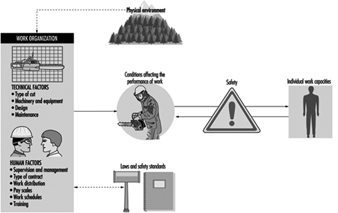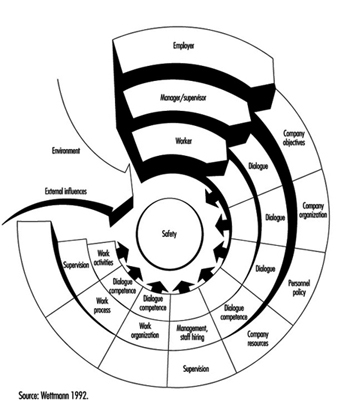Safety in the forestry sector depends on matching individuals’ work capacities to the conditions under which they perform their tasks. The closer the mental and physical requirements of the work approach the workers’ capacities (which, in turn, vary with age, experience and health status), the less likely safety is to be sacrificed in an attempt to satisfy production goals. When individual capacities and working conditions are in a precarious balance, decreased individual and collective safety is inevitable.
As figure 1 illustrates, there are three sources of safety hazards related to working conditions: the physical environment (climate, lighting, terrain, types of trees), deficient safety laws and standards (inadequate content or application) and inappropriate work organization (technical and human).
Figure 1. Determinants of safety hazards in forestry work.
The technical and human organization of work encompasses potentially hazardous factors that are both distinct and tightly linked: distinct, because they refer to two intrinsically different resources (i.e., humans and machines); linked, because they interact and complement each other during the execution of work activities, and because their interaction allows production goals to be reached safely.
This article details how flaws in the components of work organization listed in figure 1 can compromise safety. It should be noted that measures to protect safety and health cannot be retro-fitted onto an existing work method, machine or organization. They need to be part of the design and planning.
Technical Work Organization
The term technical work organization refers to operational considerations of forestry work, including the type of cut, the choice of machinery and production equipment, equipment design, maintenance practices, size and composition of the work crew(s) and the time allotted in the production schedule.
Type of cut
There are two main types of cut used in forestry operations, distinguished by the technology used to fell and debranch trees: conventional cutting, which relies on mechanical saws, and mechanical cutting, which relies on machines operated from control cabins and equipped with articulated booms. In both cases, skidders, especially chain- or claw-propelled ones, are the usual means of transporting felled trees along the side of the road or waterways. Conventional cutting is the more widespread and the more dangerous of the two.
Mechanization of cutting is known to considerably reduce the frequency of accidents. This is most apparent for accidents occurring during production operations, and is due to the replacement of mechanical saws by machines operated from remote control cabins which isolate operators from hazards. At the same time, however, mechanization appears to increase the risk of accidents during machine maintenance and repair. This effect is due to both technological and human factors. Technological factors include machine deficiencies (see below) and the often improvised, if not frankly ludicrous, conditions under which maintenance and repair operations are performed. Human factors include the existence of production bonuses, which often result in low priority being given to maintenance and repair operations and the tendency to perform them hastily.
Machine design
There are no design codes for forestry machinery, and comprehensive maintenance manuals are rare. Machines such as fellers, debranchers and skidders are often a mixture of disparate components (e.g., booms, cabins, base machines), some of which are designed for use in other sectors. For these reasons, machinery used in forestry operations may be poorly suited to some environmental conditions, especially those related to the state of the forest and the terrain, and to continuous operation. Finally, machine repair is frequently necessary but very difficult to perform.
Machine and equipment maintenance
Maintenance practices in the forest are usually corrective rather than preventive. Various working conditions—such as production pressures, the absence of strict maintenance guidelines and schedules, the lack of appropriate maintenance and repair sites (garages, shelters), the harsh conditions under which these operations are performed, and the lack of adequate tools—may explain this situation. In addition, financial constraints may operate on one-person operations or sites operated by subcontractors.
Human Work Organization
The term human work organization refers to the way in which collective or individual human efforts are administered and organized, and to training policies designed to satisfy production requirements.
Supervision
Supervision of forestry work is not easy, due to the constant relocation of worksites and the geographic dispersion of workers over multiple worksites. Production is controlled through indirect strategies, of which production bonuses and the maintenance of precarious employment status are probably the most insidious. This type of work organization does not favour good safety management, since it is easier to transmit information concerning safety guidelines and regulations than it is to ensure their application and evaluate their practical value and the extent to which they are understood. Managers and supervisors need to be clear that they have primary responsibility for safety. As can be seen in figure 2 the worker controls very few of the elements that determine safety performance.
Figure 2. Human factors have an impact on safety in forest work.
Type of contract
Regardless of the type of cut, work contracts are almost always negotiated individually, and are often of fixed or seasonal duration. This precarious work situation is likely to lead to a low priority being accorded to personal safety, since it is difficult to promote occupational safety in the absence of minimal guarantees of employment. In concrete terms, fellers or operators may find it difficult to work safely if this compromises the production goals upon which their employment depends. Longer-term contracts of guaranteed minimum volumes per year stabilize the workforce and increase safety.
Subcontracting
Subcontracting the responsibility (and costs) for selected production activities to owner-operators is becoming more widespread in the forestry sector, as a result of mechanization and its corollary, work specialization (i.e., using a specific machine for tasks such as felling, pruning, felling-pruning and skidding).
Subcontracting may affect safety in several ways. In the first place, it should be recognized that subcontracting does not reduce safety hazards as such, but merely transfers them from the entrepreneur to the subcontractor. Secondly, subcontracting may also exacerbate certain hazards, since it stimulates production rather than safety-oriented behaviour. Subcontractors have in fact been observed to neglect some safety precautions, especially those related to preventive maintenance, training of new hires, the provision of personal protective equipment (PPE) and the promotion of its use, and the observance of safety rules. Finally, the responsibility for safety maintenance and management at worksites where subcontracting is practised is a judicial grey zone. It may even be difficult to determine the responsibility for declaring accidents to be work related. Work contracts should make compliance with safety regulations binding, include sanctions against offences, and assign responsibility for supervision.
Division of labour
The division of labour on forestry sites is often rigid and encourages specialization rather than flexibility. Task rotation is possible with conventional cutting, but is fundamentally dependent on team dynamics. Mechanized cutting, on the other hand, encourages specialization, although the technology itself (i.e., machine specialization) is not the sole cause of this phenomenon. Specialization is also encouraged by organizational factors (one operator per machine, shift work), geographic dispersion (remoteness of machines and cutting zones) and the fact that operators commonly own their machines.
Isolation and communication problems resulting from this division of labour may have serious consequences for safety, especially when they hamper the efficient circulation of information concerning imminent dangers or the occurrence of an incident or accident.
Work capacities of machines and workers need to be carefully matched and crews composed accordingly, to avoid overloading elements in the production chain. Shift schedules can be designed that maximize the use of expensive machines but give enough rest and variety of tasks to the operators.
Production-based pay scales
Forestry workers are frequently paid on a piece-work basis, which is to say that their salary is determined by their output (number of felled, pruned or transported trees, or some other index of productivity), not by its duration. For example, the rate which machine owners are paid for the use of their machines is proportional to their productivity. This type of pay scale, while not directly controlling workers, is notorious for stimulating production.
Production-based pay scales may encourage high work rates and the recourse to unsafe work practices during production and short-cuts in maintenance and repair operations. Practices like these persist because they save time, even though they ignore established safety guidelines and the risks involved. The greater the production incentive, the more safety is compromised. Workers paid on the basis of production have been observed to suffer more accidents, as well as different types of accidents, than hourly-paid workers performing the same type of work. Piece rates and prices for contracts need to be adequate for safe execution and acceptable working hours. (For a recent empirical study in Germany, see Kastenholz 1996.)
Work schedules
In the forest, long daily and weekly work schedules are the norm, since worksites and cutting zones are remote, work is seasonal, and the often difficult climatic and environmental factors encourage workers to work as long as possible. Other factors encouraging longer work schedules include production incentives (pay scales, subcontracting) and the possibility of using certain machines on a continuous basis (i.e., without stopping at night).
Long work schedules often result in decreased vigilance and a loss of sensory acuity, both of which may have effects on individual and collective safety. These problems are aggravated by the rarity and brevity of rest periods. Planned breaks and maximum working hours should be observed. Ergonomic research demonstrates that output can actually be increased that way.
Training
There can be no doubt that forestry work is physically and mentally demanding. The skill level required is continually increasing, as a result of technological advances and the growing complexity of machines. Prior and onsite training of forestry workers are therefore very important. Training programmes should be based on clearly defined objectives and reflect the actual work to be performed. The more the training programmes’ content corresponds to actual working conditions and the greater the integration of safety and production concerns, the more useful the programmes will be, both individually and collectively. Effective training programmes not only reduce material losses and production delays but also avoid additional safety hazards. For guidance on training, see “Skills and training” in this chapter.
Conclusion
The safety of forestry work is determined by factors related to work organization, and technical and human aspects of work organization may disrupt the equilibrium between production goals and safety. The influence of each individual factor on occupational safety will of course vary from setting to setting, but their combined effect will always be significant. Furthermore, their interaction will be the prime determinant of the degree to which prevention is possible.
It should also be noted that technological developments do not, in and of themselves, eliminate all hazards. Design criteria for machines should take into account their safe operation, maintenance and repair. Finally, it appears that some increasingly widespread management practices, especially subcontracting, may exacerbate rather than reduce safety hazards.


